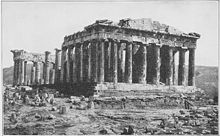Curvature

In architecture, a curvature is an intentional, slight curvature of a building edge that is actually straight. The curvature robs the building of its cool severity; Although it is hardly noticeable, it subordinates the individual parts to the overall concept of the building and breaks up the geometric rigidity of the lines, making the building appear more harmonious and lively. An exact, perception-theoretical justification for this effect is not known.
The curvature was probably developed in ancient Greek architecture in archaic times . The earliest building on which a curvature can be observed is the Temple of Apollo in Corinth from the middle of the 6th century BC. BC, but not conclusively provable due to its small remains. From the Greek Classical period , the curvature is widespread in ancient architecture, especially in temple construction , but also, for example, in columned halls ( stoa ) and, in Roman times, on multi-story facades structured by aedicules and rows of columns .
The curvature extends to all horizontal structural elements of a building front. The stepped structure and the entablature above the columns rise slightly towards the center in the form of a flat curve (about 2 cm at the Temple of Apollo Corinth, about 20 cm at the Temple of Apollo at Didyma ). At temples, the curvature was sometimes not only applied to the facade, but extended over the entire base of the building, which is thus spherically curved. This means that the components not only rose slightly towards the center of the facade, but also towards the inside of the building.
The curvature was first identified and described by historical building research in the 1860s by the architect Ernst Ziller at the Parthenon in Athens , but remained controversial for some time, for example by Josef Durm . The term curvature was introduced by modern research, the ancient Greek name is unknown, the Latin name adiectio (addition) in Vitruvius is also uncertain. To this day, the exact geometric curve of the curvature is controversial in research. The shape of a parabola or an ellipse is discussed for individual buildings .
Vitruvius mentions scamilli impares ("uneven benches") as a process for the technical production of the curvature . What one should imagine here was completely unclear until a few years ago a building finding was associated with this: According to this, individual measurement marks were sunk into the apparently not yet finished top of a layer of stones, the bottom of which was at the same height. Afterwards, measuring plates (benches) of different heights were inserted, which indicated how far the upper side had to be worked off in order to create the curvature.
Others in the ancient architectural methods used refinement are a slight inward inclination ( inclination ) of the columns, amplifying certain columns (at the corners or on the front of the building), or a swelling of the column shaft , the so-called Entasis .
literature
- Ernst Ziller : About the original existence of the curves of the Parthenon , Athens 1864.
- Ernst Ziller: About the original existence of the curves of the Parthenon . In: Zeitschrift für das Bauwesen 1865, Sp. 35–54.
- Lothar Haselberger : Antique plan drawings at the Temple of Apollo at Didyma . Spectrum of Science, April 1985, pp. 70-83
- Lothar Haselberger (Ed.): Appearance and Essence. Refinements of Classical Architecture: Curvature. University of Pennsylvania Press, Philadelphia 1999.
Individual evidence
- ^ Lothar Haselberger: Antique plan drawings at the Temple of Apollo at Didyma . Spectrum of Science, April 1985, pp. 70-83.
- ↑ Ernst Ziller: About the Original Existence of the Curvatures of the Parthenon , Athens 1864.
- ^ Josef Durm: Constructive and polychrome details of Greek architecture . In: Zeitschrift für Bauwesen 1879, p. 414.
- ↑ Vitruv de architecura 3, 4, 5: “Sin autem circa aedem ex tribus lateribus podium faciendum erit, ad id constituatur uti quadrae spirae trunci coronae lysis ad ipsum stylobatam qui erit sub columnarum spiris conveniant. stylobatam ita oportet exaequari uti habeat per medium adiectionem per scamillos inpares. si enim ad libellam dirigetur, alveolatus oculo videbitur. hoc autem ut scamilli ad id convenientes fiant, item in extremo libro forma et demonstratio erit descripta. "
- ↑ Hans Georg Bankel : Scamilli inpares at at Early Hellenistic Ionic propylon at Knidos . in: Haselberger 1999, pp. 127-138
